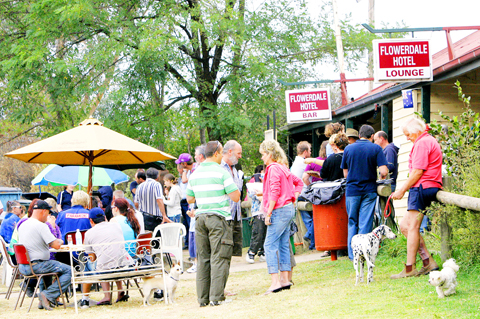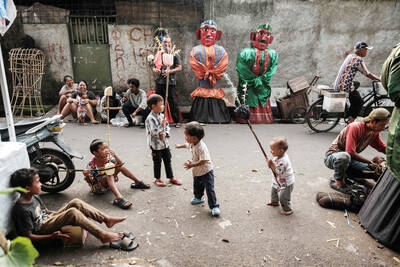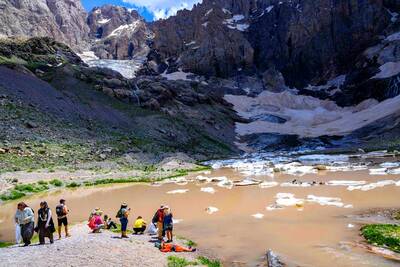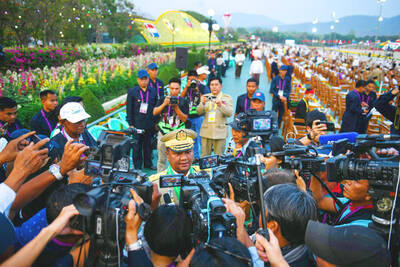Outside the town pub where a light rain is instantly sucked up by the fire-scorched earth, the people of Flowerdale are planning a resurrection.
The materials are ready for a village of portable homes. The kindergarten children whose school burned are playing at the community center. The hungry get hot meals and cold drinks.
Two weeks have passed since wildfires swept southern Australia, killing at least 209 people and leaving 7,500 homeless. Most survivors are just beginning the long process of getting government aid to rebuild.

PHOTO: AP
For the 1,500 residents of Flowerdale, where about 80 percent of the residents lost their homes and at least eight people died, waiting to be rescued would not do. So they decided to save themselves.
“We’re not gonna stand still — we never have,” said Steve Phelan, owner of the town pub, the Flowerdale Hotel — one of the few buildings left standing in this blackened wasteland. “We just got out of bed and we got up and got going.”
In towns across Australia, the pub is the social center. In Flowerdale, it has become the survival center. It was a refuge for dozens who huddled inside its wooden walls as fires bore down on the village. And it was a gathering spot for shaken survivors the morning after the Feb. 7 inferno.
It was at the pub, too, where the people realized help from outsiders would not come quickly. If the town had any hope of a future, resident John Burgess said, the people needed a reason to stay.
And so they appointed a council and named Burgess the town spokesman. Every day at 9am, survivors gather around the pub’s picnic tables and set to work. A plan for a temporary village of portable homes was quickly drafted. A cluster of tents was erected for those who had no place else to go.
Everyone was given a job. Teachers and volunteers went to the community center to watch children who no longer had a school.
Residents worked their contacts and got donations of food, water, clothes and construction materials. Some focused on arranging meetings with officials who could help restore essential services and send in supplies.
In one neighborhood tucked between fire-scarred hills, just two houses out of 40 still stand and a purple swing set is the lone spot of color in a sea of black, brown and gray. All is quiet, but for the rustling of charred leaves and the squeak of a decorative metal windmill, warped by heat, but still turning.
There are sounds of progress. Trucks toting away the wreckage rumble down the road. A wood chipper whines as dead trees are collected and fed into its jaws. A telephone line repairman chats with visitors as he twists wires this way and that.
On Friday, the first portable home was ready to go up in a field next to the community center. A development of 50 is planned, complete with running water and power, streetlights and exercise areas, Burgess said. How it will be funded has not been fully determined, he said, but much of the material has already arrived.
“There’s just not a model that says ‘this is what we do after having a bush fire that wrecks the town,’” he said. “We’d like to think that we’ve got forward thinking here — that we’re building that model now.”
Lyn Gunter, mayor of Murrindindi Shire, where Flowerdale is located, said it was important to give the residents control and not dictate what they should do.
“They need to be where they are comfortable, where they are safe,” Gunter said. “I don’t think any of us would have thought this would happen so quickly, but it shows the community spirit behind all of this.”
Flowerdale resident Debbie Bourke stopped by the pub for the morning meeting and picked up some new pink pajamas for her four-year-old daughter, Shawnee. The family is living in a tent and the children stay warm at night in their sleeping bags. She said the tenacity of Flowerdale’s people gives her hope.
“You can’t knock Flowerdale. They won’t get us off our hill,” she said. “We’ll stay and we’ll rebuild, even if we have to do it one house at a time. It’ll all come back.”

In the sweltering streets of Jakarta, buskers carry towering, hollow puppets and pass around a bucket for donations. Now, they fear becoming outlaws. City authorities said they would crack down on use of the sacred ondel-ondel puppets, which can stand as tall as a truck, and they are drafting legislation to remove what they view as a street nuisance. Performances featuring the puppets — originally used by Jakarta’s Betawi people to ward off evil spirits — would be allowed only at set events. The ban could leave many ondel-ondel buskers in Jakarta jobless. “I am confused and anxious. I fear getting raided or even

Kemal Ozdemir looked up at the bare peaks of Mount Cilo in Turkey’s Kurdish majority southeast. “There were glaciers 10 years ago,” he recalled under a cloudless sky. A mountain guide for 15 years, Ozdemir then turned toward the torrent carrying dozens of blocks of ice below a slope covered with grass and rocks — a sign of glacier loss being exacerbated by global warming. “You can see that there are quite a few pieces of glacier in the water right now ... the reason why the waterfalls flow lushly actually shows us how fast the ice is melting,” he said.

RISING RACISM: A Japanese group called on China to assure safety in the country, while the Chinese embassy in Tokyo urged action against a ‘surge in xenophobia’ A Japanese woman living in China was attacked and injured by a man in a subway station in Suzhou, China, Japanese media said, hours after two Chinese men were seriously injured in violence in Tokyo. The attacks on Thursday raised concern about xenophobic sentiment in China and Japan that have been blamed for assaults in both countries. It was the third attack involving Japanese living in China since last year. In the two previous cases in China, Chinese authorities have insisted they were isolated incidents. Japanese broadcaster NHK did not identify the woman injured in Suzhou by name, but, citing the Japanese

RESTRUCTURE: Myanmar’s military has ended emergency rule and announced plans for elections in December, but critics said the move aims to entrench junta control Myanmar’s military government announced on Thursday that it was ending the state of emergency declared after it seized power in 2021 and would restructure administrative bodies to prepare for the new election at the end of the year. However, the polls planned for an unspecified date in December face serious obstacles, including a civil war raging over most of the country and pledges by opponents of the military rule to derail the election because they believe it can be neither free nor fair. Under the restructuring, Myanmar’s junta chief Min Aung Hlaing is giving up two posts, but would stay at the